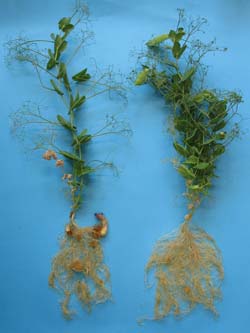Scientists discover new plant hormone

Two pea plants: One normal plant and a mutant that cannot produce strigolactones. The second plant is branched. The image also shows parasitic plants growing on the roots of the regular pea plant, while the mutant plant is parasite-free.
Scientists from the Wageningen University Laboratory of Plant Physiology and an international team of scientists have discovered a new group of plant hormones, the so-called strigolactones. This group of chemicals is known to be involved in the interaction between plants and their environment.
The scientists have now proven that strigolactones, as hormones, are also crucial for the branching of plants. The discovery will soon be published in Nature and is of great importance for innovations in agriculture. Examples include the development of cut flowers or tomato plants with more or fewer branches. These crops are of major economic and social importance worldwide.
The growth and development of plants is largely controlled by plant hormones. Plants produce these chemicals themselves, thus controlling the growth and development of roots and stems, for example. A number of plant hormones, such as auxins, giberellins and cytokinins, were discovered by scientists decades ago. Now a new group of hormones has been found: The so-called strigolactones.
Previous research by institutes including Wageningen UR has shown that strigolactones plays a major part in the interaction between plants and their environment. As plants cannot move, they commonly use their own chemicals to control the environment as best as they can.
Strigolactones are of major importance to the interaction between plants and symbiotic fungi, for example. These fungi live in a symbiotic relationship with plants, lthat is mutually beneficial. They transport minerals from the soil to the plant, while the plant gives the fungi sugars ‘in return’.
Unfortunately, the strigolactones have also been “hijacked” by harmful organisms: They help seeds of parasitic plants to germinate when plant roots are in the vicinity. The seedlings of the parasite attach to the root of the plant and use the plant’s nutrients for their own growth and reproduction. Unlike the symbiotic fungi, however, they do not give anything in return. On the contrary, the parasitism often causes the host plant to die, eventually.
The international research team consisting of French, Australian and Dutch scientists, coordinated in France, found mutants of pea that were branching without restraint. It turned out that these pea plants were not capable of producing strigolactones. When the plants were administered strigolactones, the unrestrained branching stopped. The same effect occurred in an entirely different plant, thale cress. The mutant plants also caused a significant lower germination of the parasitic plant seeds and induced less interaction with symbiotic fungi.
The scientists also showed that a specific ‘receptor reaction’ for the strigolactones occurs in plants, a phenomenon that is characteristic for plant hormones. Although some previously discovered plants with unrestrained branching turned out to be producing strigolactones themselves, their receptor connection was disturbed: Strigolactones administered from the outside could not stop the uncontrolled branching.
It has also been shown that the plants are capable of transporting strigolactones internally and that the chemicals work at very low concentrations, two other typical characteristics of plant hormones.
The importance of this discovery of a new group of plant hormones is emphasised by the fact that Nature is publishing an article by a Japanese team in the same issue in which similar results are presented. It is expected that this new knowledge will be applied in agriculture and horticulture, for example in breeding and the development of branching regulators.
Cut flower varieties and potted plants with either more or less branching may have special ornamental value, while crops with more or less branching may be beneficial in cultivation. Tomato plants in which less branching occurs can benefit the greenhouse horticulture, for instance.
Plant breeding and greenhouse horticulture are key agricultural industries in the Netherlands and strongly focussed on innovation.
Media Contact
More Information:
http://www.wur.nlAll latest news from the category: Agricultural and Forestry Science
Newest articles

Combatting disruptive ‘noise’ in quantum communication
In a significant milestone for quantum communication technology, an experiment has demonstrated how networks can be leveraged to combat disruptive ‘noise’ in quantum communications. The international effort led by researchers…

Stretchable quantum dot display
Intrinsically stretchable quantum dot-based light-emitting diodes achieved record-breaking performance. A team of South Korean scientists led by Professor KIM Dae-Hyeong of the Center for Nanoparticle Research within the Institute for…

Internet can achieve quantum speed with light saved as sound
Researchers at the University of Copenhagen’s Niels Bohr Institute have developed a new way to create quantum memory: A small drum can store data sent with light in its sonic…





















